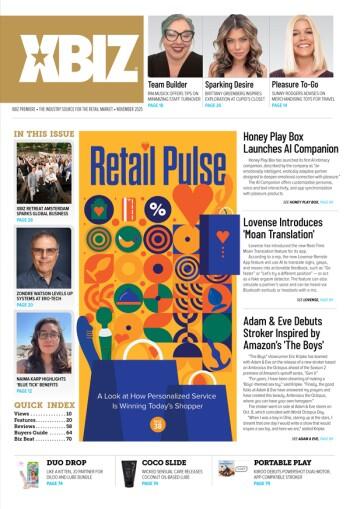Inclusivity has evolved from buzzword to business norm. Once just a trendy term, it’s now redefining whole sectors — including the pleasure industry. The more adult stores grow and gain consumer support, the more important it becomes for them to adopt inclusive practices.
Like everyone, I love competing. After all, staying ahead of the competition is one of the keys to succeeding in business! However, I am also of the opinion that working collectively to support our customers will improve the industry as a whole and attract more customers for us all.
Being truly inclusive means always trying to do better, keeping up with changing social norms and listening to customers.
As I see it, there are four different layers of inclusivity, all of which complement each other: diverse product offerings, user experience, website accessibility and the basics.
Product Offerings
Each customer is different, with their own gender, sexual orientation and body shape. Inclusivity means recognizing and valuing all the different types of people out there. That begins with having products that match this wide variety of people. Offering a diverse selection of products isn’t just good for business; it’s a way to make customers feel welcome, seen and respected.
If you’re not certain about how particular products fit particular people’s needs, collaborating with bloggers, educators and sex workers is a great way to go. Not sure which products are great fit for couples? Reach out to pleasure product reviewers Super Smash Cache, Epiphora or Princess Previews. Not sure which products are a great fit for trans folks? Reach out to Betty Butch. Not sure which products are great for older folks? Reach out to sex educator Joan Price. This can help you understand the product needs of diverse communities and identify improvement opportunities.
Of course, stocking all the products in the world will still mean nothing if customers can’t find what they’re looking for, which brings me to my next point.
User Experience
When a customer walks into a retail store, they have the option to interact with staff working in the store. They can inquire about the products, express their needs and get the help they require. However, that option does not exist in the online environment. There is nobody to talk to, users are wary of the little chat bubbles in the corner and email support simply does not cut it, as it takes too much time to get a response.
That’s why it’s so important to set up your website to provide a flawless user experience that leads visitors to the right products. You still achieve a great, inclusive user experience by sorting products in nontraditional categories, and making sure those products display all the necessary tags and interpretation.
For example, some of the categories we have implemented are: for penis folks, for vagina folks, for bigger bodies, for older folks, for trans folks and so on. Then, within the category, each product is labeled with tags such as “allows for farther reach,” “resting arm,” “arthritis-friendly,” “smooth,” “textured,” “ergonomic handle,” “finger loop,” etc.
Even basic information like whether a toy plugs in, is battery-powered or rechargeable can be important to folks. Additionally, product descriptions should be modified to make them more informative and complete. As someone who went through the process of altering more than 1,000 product descriptions, I know how painstakingly frustrating that task can be. But it is important. Visitors should not have to guess why a product is categorized or tagged a certain way. A great user experience makes sure potential customers are never left wondering.
For example, with Le Wand massagers, I have added additional lines to the product description, such as “Its longer handle allows for farther reach and simpler use, also allowing it to be used while the hand is resting,” which might be useful to older folks, bigger folks and folks who experience limited mobility, and “Wand handles can be useful for coping with bottom dysphoria because they put distance between the user’s hand and their genitals,” which might be helpful to trans folks.
Any special considerations should also be added to each product description, since product images often do not portray details such as size, weight and orientation and positioning while using. That is where special considerations come in. Lines like “Needs active grasp or hand mobility/dexterity to use or position the toy” or “Need active grasp and strength in hand to plug in the toy” can mean the world to some customers. Adding this level of clarity to the user experience helps customers find what suits them best — and reduces the chances that they will end up with a product they can’t use or return.
Finally, product descriptions for many lower-quality mass-produced brands still unfortunately feature wildly broad assumptions about gender. I’m hoping this article will nudge some of them in the right direction! Not everyone is straight, not everyone wants to “give her what she craves the most.” We’re past those times.
Website Accessibility
Online sex shops should be easy for everyone to use, including people with disabilities. This means adapting the website to accommodate a wide range of users. Think: adding detailed alt descriptions for images, making the site easy to read with screen readers, using clear text, not using overly bright colors, using enough contrast, etc.
Initially this may sound like the bane of a website developer’s existence, or something bound to cost a fortune. However, I can recommend some very feasible options. You can install a plug-in like accessiBe or UserWay, without the need to hire an expensive coder. The plug-in sits in the corner of your website and its interface lets any visitor adjust the site design to fit their accessibility needs. Depending on the size of your site, the bill for that might be upwards of $100 per month, but you will have a completely ADA-ready site with just a few clicks.
If that is too much for your budget, UserWay also offers a free version of the plug-in. It doesn’t offer all the functionality, but it serves well. It has been encouraging to see stores like SheVibe, Spectrum Boutique and Tantus installing it on their website. However, some of the bigger prominent outlets are still lacking such a fix.
The Basics
These last few steps should be a matter of common sense to any retailer, but I will mention them since they comprise the bare essentials of inclusivity: Interaction with customers should always be kind and respectful. There should be no place for any kind of discrimination. Personal information should be carefully stored and kept private. Packaging should be discreet, as should payment statements.
All of the above suggestions should prove helpful, but they are also all just starting points. Being truly inclusive means always trying to do better, keeping up with changing social norms and listening to customers. Being inclusive is not only the right thing to do but is also good for business. Companies that get this will be the ones to lead the way into the future.
Luka Matosic is an engineer, a sex toy aficionado and a serious taco enthusiast. Alongside his wife, Leja, he has established the “Spices of Lust” blog, Raw Love Studio toys and online store The Sex Shed.








